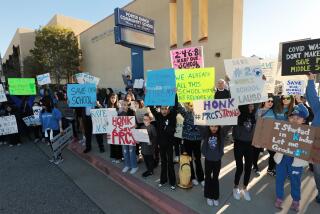Neighbors at Odds on Franciscan Site Plans
- Share via
A proposal to build a high school rather than a shopping center on the contaminated site of the former Franciscan Ceramics factory in Atwater is pitting hometown residents against neighbors in Los Feliz.
Just a week after the Los Angeles Board of Education ordered a formal study of the Franciscan site as a potential school, residents of the adjoining communities find themselves in general disagreement, although their positions are not firm because of a number of outstanding questions.
A majority of Atwater residents appear to favor the conveniences of a shopping center to the perceived rowdiness and other problems that thousands of high school teen-agers could bring, said Ed Waite, president of the Atwater Homeowners Assn.
Directors of the Los Feliz Improvement Assn., which has long voiced alarm about overcrowding at local schools, have thrown their clout toward a high school, or even a combined junior and senior high school, on the 45-acre plot of dilapidated and partially dismantled brick buildings at 2901 Los Feliz Blvd.
Uncertainties Exist
Beyond those first impressions, however, are uncertainties on both sides. Waite said he wonders if a shopping center would lead to traffic congestion and urban crime that would be worse than any problems of teen-age gangs and drugs that some residents fear a school would bring.
He also said some owners of Atwater businesses worry that a large neighborhood shopping center may hinder, rather than enhance, their own enterprises.
And veteran school observers question whether the Franciscan site, on the border of Glendale, is the answer to school crowding centered more than five miles away in the mid-Wilshire and downtown areas.
Schurgin Development Corp. of Los Angeles, a leading developer of shopping centers in California, has been working for years to develop a plan to clean up toxic wastes on the Franciscan property, contaminated over decades by the dumping of lead, zinc and other materials from the manufacture of ceramic dinnerware and tile.
Schurgin purchased the property in November and plans to build a $110-million shopping center there with a major supermarket, theater, restaurants, auto parts store and other convenience retailers.
Cleanup Requires Approval
A contamination cleanup plan, about to be approved by state health officials, could cost Schurgin more than $15 million, company officials said.
But after state health officials gave assurances that the property would also be safe for a school, the school board last week authorized an environmental study of the site. Officials of the Los Angeles Unified School District said the vacant property could be ideal to meet the district’s need for school sites because homeowners and renters would not be displaced.
Despite Schurgin’s protests, school officials have the power to obtain ownership of the Franciscan property through eminent domain proceedings.
The Los Feliz Improvement Assn., which has 1,200 homeowner members, is urging the school district and Los Angeles city officials to endorse the proposal for a new high school at the Franciscan site to relieve overcrowding at Belmont, Marshall and Eagle Rock high schools.
Crowding in the schools and a burgeoning housing crunch “is the No. 1 problem” in the area, said Marilyn Bush, a board member of the Los Feliz association. She said the school district is wasting thousands of dollars annually on busing students to schools outside the area that could be resolved by building a new facility in Atwater.
Some school district officials are skeptical, saying the Franciscan site is too far from the inner-city congestion. Rita Walters, a member of the Board of Education, last week urged that the district concentrate on acquiring downtown Los Angeles property to relieve overcrowding.
Others, however, said any land that can be acquired without displacing housing is vital to meeting the district’s needs. “We have ended up with thousands and thousands of students on buses every day just to find a seat in the classroom,” Bush said. “It costs about $1,000 just to bus one student a year. So if you have 20,000-plus students on buses, those are dollars that are just going down the drain without any educational benefits.
“We want to see students go to school in their own neighborhood.”
More to Read
Sign up for Essential California
The most important California stories and recommendations in your inbox every morning.
You may occasionally receive promotional content from the Los Angeles Times.













